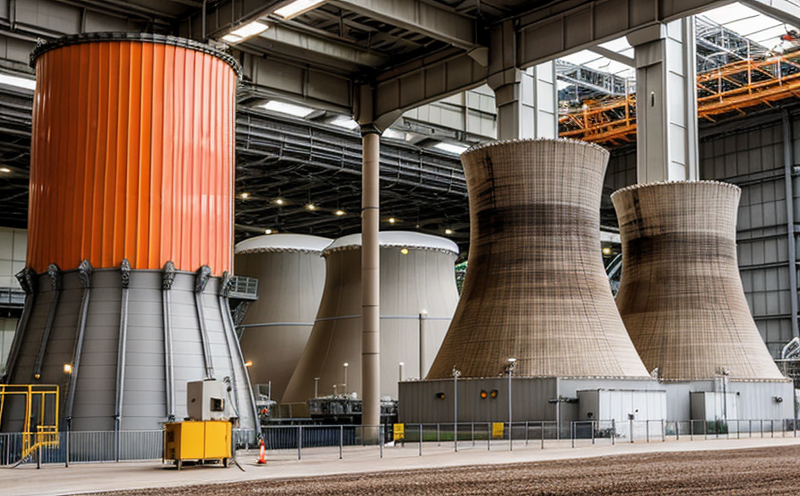ISO 4993 Radiographic Testing of Nuclear Cast Components
The ISO 4993 standard specifies radiographic testing methods to detect and assess flaws in nuclear cast components. This service is critical for ensuring the integrity of materials used in the construction of nuclear power plants, where even minor defects can lead to catastrophic failures with severe consequences.
Materials such as iron, nickel, and their alloys are commonly used in the casting process for nuclear components like reactor pressure vessels, steam generators, and primary piping. These components must withstand extreme conditions including high temperatures, radiation exposure, and mechanical stress. Therefore, radiographic testing is an essential non-destructive evaluation (NDE) method to identify internal defects that could compromise the structural integrity of these critical components.
The process involves subjecting the cast component to X-rays or gamma rays, which penetrate through the material and are attenuated based on the density variations within the cast. The resulting radiographic image provides a detailed view of any discontinuities, such as cracks, porosity, shrinkage, and inclusions that may be present inside the casting.
Radiographic testing is particularly suited for nuclear cast components because it can evaluate large volumes of material with high resolution, allowing for comprehensive inspection without altering or damaging the part. This makes it an indispensable tool in quality control processes for nuclear power plant materials and components.
In accordance with ISO 4993, the radiographic testing process requires stringent adherence to several key parameters:
- Use of appropriate radiation source (X-ray or gamma ray) depending on component size
- Selection of suitable film and intensifying screens for optimal image quality
- Application of proper exposure conditions including voltage, current, and exposure time
- Ensuring the uniformity of the test field by positioning the component correctly within the examination area
- Development and interpretation of radiographic images to identify flaws based on established criteria
- Maintenance of accurate records for traceability and future reference
The acceptance criteria for defects in nuclear cast components are strictly defined by regulatory bodies such as the International Atomic Energy Agency (IAEA) and national standards like ASME and EN. These criteria ensure that any flaw exceeding a specified threshold must be addressed before the component can be used in a power plant.
Benefits
The use of ISO 4993 radiographic testing offers several advantages, particularly for stakeholders involved in nuclear power plant construction and maintenance:
- Enhanced Safety: Identifying internal flaws before the component is assembled into a reactor reduces the risk of accidents caused by structural failures.
- Cost Efficiency: Early detection of defects allows for timely repair or replacement, preventing costly downtime and rework during plant operation.
- Regulatory Compliance: Ensuring adherence to international standards like ISO 4993 helps facilities meet stringent regulatory requirements without compromising safety.
- Prolonged Service Life: By eliminating defects that could lead to premature failure, the service contributes to longer operational life of nuclear power plant components.
The ability to perform thorough inspections non-destructively is a significant benefit over other testing methods. This ensures that critical materials remain available for use in sensitive applications without the need for costly and time-consuming re-manufacture processes.
Quality and Reliability Assurance
Ensuring the reliability of radiographic testing results is crucial to maintaining high standards in nuclear power plant operations. Quality assurance (QA) measures must be implemented throughout every stage of the testing process:
- Operator Qualification: All operators performing ISO 4993 tests must undergo rigorous training and certification.
- Equipment Calibration: Testing equipment should be regularly calibrated to ensure accurate results.
- Standard Operating Procedures: Strict adherence to established protocols minimizes variability in testing outcomes.
- Data Verification: Independent verification of test results by qualified personnel ensures accuracy.
The use of advanced technologies and software tools further enhances the reliability of radiographic testing. For instance, digital radiography (DR) systems provide real-time imaging that can be immediately evaluated for defects. Additionally, computer-aided defect analysis software helps in quantifying flaw sizes and shapes with precision.
Use Cases and Application Examples
The following table illustrates typical use cases for ISO 4993 radiographic testing in nuclear cast components:
| Component Type | Flaw Detection | Risk Level |
|---|---|---|
| Reactor Pressure Vessel | Critical flaws that could lead to catastrophic failure | Highest Risk |
| Steam Generator Tubes | Small cracks and corrosion pits | Moderate Risk |
| Primary Piping | Cracks and voids in welds | Medium Risk |
A second table provides examples of defects commonly detected during ISO 4993 testing:
| Defect Type | Description | Acceptance Criteria |
|---|---|---|
| Cold Shut | A region where the metal did not fully fuse during casting | No cold shuts are allowed as they can lead to significant structural weaknesses. |
| Porosity | Small voids or bubbles within the material | Porosity should be minimal and confined to acceptable limits defined by IAEA standards. |
| Inclusions | Foreign materials trapped during casting | Inclusions must not impede the structural integrity of the component. |
These examples highlight the importance of ISO 4993 radiographic testing in ensuring that nuclear cast components meet stringent quality standards. The detection and elimination of defects are paramount to the safe operation of nuclear power plants.





